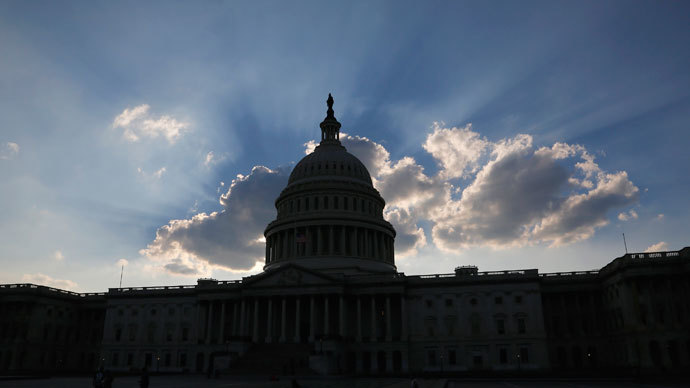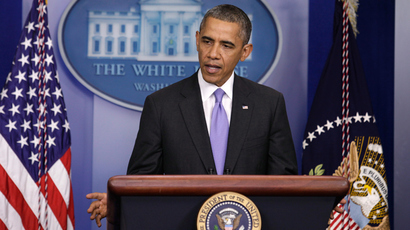Demystifying the US debt ceiling: 5 things you should know

As the US government is about to hit its so-called debt ceiling of $16.7 trillion on Oct. 17, the frightening prospect of the world’s biggest economy running out of cash is dominating headlines around the globe.
So, in an effort to shine some light on what exactly the debt
ceiling means to all of us, Business RT spoke to leading
Moscow financial expert Chris Weafer, a senior partner at Macro
Advisory, a Moscow-based consulting firm.
1 What exactly is the “debt ceiling?”
The US debt ceiling has existed for almost a century, and describes the maximum amount of money the US can legally borrow. The country introduced the legislative limit on its debt back in 1917, and since then it has stipulated the affordable amount of national debt that can be issued by the US Treasury. As of September 25, the US Treasury reported federal government debt at just shy of $16.7 trillion ($16,699,396,000,000.00, to be exact) in its daily statement, a figure which has been reported for 130 days straight. This is about $25 billion shy of the precise legal limit – $16,699,421,095,673.60. When the US approaches this debt limit, it can take some “extraordinary measures” to buy some time before Congress agrees to raise the ceiling. In its entire history, the US has so far never reached the point of default, where Treasury can’t pay its debt obligations.
2 Who holds the US debt?
The US owes about two-thirds of its debt to US-based creditors,
with almost 66 percent of the country’s debt held domestically.
US individuals and financial institutions hold around 31.7
percent of US Treasuries, with the US central bank, the Federal
Reserve, which holds some 12 percent of the debt. Foreign
creditors, including China and Japan, own an estimated 34 percent
of total US government debt. These two 'big lender' countries
have recently urged the US to take decisive steps to avoid a
default.
3 What does the US borrow the money for?
In the US, often referred to as a 'big-spending' country, both individuals and the government have habitually spent more than they earn, pushing the economy deeper into debt.
“Just like any ordinary individual, the choice is either to cut back on spending or to borrow money to bridge the gap,” Weafer says.
In 2012, 22 percent of total government expenditures went to social security (means-tested payments to the poor and unemployed), while 21 percent was spent on healthcare, again mostly for poor Americans who cannot afford private health insurance. The third largest expenditure item is defense at 19 percent. In recent decades, the US defense bill has ballooned, mainly due to costly wars in Iraq, Afghanistan and elsewhere. The so-called War on Terror has also added greatly to the debt burden, while the Department of Homeland Security, created after the September 11, 2001, attacks on the US, has cost taxpayers more than a cumulative $800 billion.
The biggest contributory factor to the fast-growing debt mountain in recent years, however, has been the economic crisis that began in 2008. Apart from hundreds of billions of dollars paid out to rescue failing Wall Street banks that had made too many toxic loans, the US government has also paid out large amounts on vital social programs to aid the growing 'army of the unemployed'. Coupled with the Bush-era tax cuts to the rich and big business, lower average incomes and greater unemployment have hit government tax revenues hard, sending federal government debt sky-high.
4 Why can’t they simply print more dollars and pay their debt?

No economy in the world can simply turn on its printing presses
and create as much cash as it wishes, as this would make its
currency worthless.
“If the amount of currency in issue is not sensibly related to the strength of the economy, then foreign trade partners will … devalue the currency quickly,” Weafer explains. “If you have one asset and income source which allows you to issue one dollar, and then you print one more dollar, everybody else will see what you have done and will value your one dollar at only 50 cents. Some countries have done that in the past, but in those cases people soon had to use suitcases just to carry enough currency to buy a loaf of bread.”
Under the Bretton Woods financial system, established in 1944, the amount of currency in circulation was linked to gold reserves. But in 1971, the US abandoned this system and started to include a number of other economic factors, based on a recognized ability to service debt and prevent inflation, and maintain orderly trade with the rest of the world.
5How would a US default affect people around the world, on a macro and personal level?
If the US defaulted, then the world’s financial system “would start to freeze up,” Weafer says. “Banks would pull back from risk and lending. The US economy would slide towards recession and the global economy would quickly be affected.” A prolonged US default would lead to job losses everywhere and much tougher borrowing conditions for companies and individuals, he adds.
“A short period of default would also have a bad effect in that it would hurt confidence in the world’s financial system,” he says. “Bankers and investors would assume that a short-term fix in the US would mean it would only be a matter of time before the same issue arises again in 2014. The resulting caution would make life that much tougher for all of us.”














